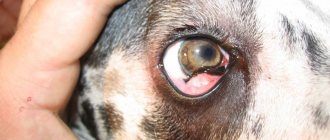If until recently the manifestation of allergic reactions in four-legged friends was considered rather an exception to the rule, today this disease is far from uncommon. This is not surprising, since the number of possible allergens is increasing every day.
It is quite difficult to definitively establish that the disease manifested in an animal is an allergy. Only a veterinarian can make accurate conclusions in this case.
Therefore, the most correct decision at the slightest suspicion that your pet has an allergy is to show it to a specialist.
Causes of allergies
An allergic reaction is the result of hypersensitivity to a foreign substance that has entered the animal's body.
Under normal conditions, all foreign components are eliminated from the body naturally, without causing any particular inconvenience to the pet.
In dogs susceptible to an allergic reaction, an inflammatory process begins, during which histamine enters the blood.
The presence of this element causes redness, skin rashes and severe itching in various areas of the skin.
Help with anaphylactic shock in a dog
The state of anaphylactic shock can occur suddenly as a result of a sharp response of the animal’s body to an insect bite, taking or injecting medications, or vaccination. It is characterized by the following symptoms:
- swelling of the muzzle, eyes, mouth, nose, ears;
- rash and redness, swelling at the injection site;
- vomiting reflex;
- an excited state turning into a depressed state;
- heart rhythm disturbance;
- fainting state.
If such signs occur, the animal must be urgently taken to a veterinarian. The pet may die within the next hour!
First of all, the specialist will give an intramuscular injection of an antihistamine, for example, diphenhydramine. To maintain heart function, an intravenous infusion of cordiamine or an injection of sulfocamphocaine under the skin will be required. In addition, the veterinarian will administer a mixture of vitamin C and glucose intravenously, an immunomodulatory agent (for example, Immunofan) intramuscularly, and a steroid drug subcutaneously. Further actions will depend on the condition of the dog.
Features of the course of the disease
In comparison with other animals and humans, the course of the disease in dogs has its own characteristic differences:
- more complex nature of the disease;
- an extensive list of allergy-causing components;
- disease progression with age;
- characteristic skin manifestations.
Additional complications include wounds caused by scratching the body. Through such damage, pathogenic microbes often enter the body, which leads to a number of concomitant diseases.
The most common of them is purulent inflammation of the skin.
What Causes Dog Allergies
Why can't many people get along under the same roof with their pet? The reason is very simple. All waste products of dogs, like many other animals, contain proteins foreign to our body. They are perceived by the human immune system as an enemy that needs to be gotten rid of. These proteins are contained:
- in urine;
- in feces;
- in saliva;
- in the secretions of the sebaceous glands;
- in keratinized skin particles.
So it turns out that the cause of the allergy is not dog hair, but a protein that gets on the fur and spreads throughout the apartment. It settles on the mucous membranes of internal organs. If the patient’s immunity is very weak, then the reaction to the stimulus appears almost immediately. When an allergy to a dog appears, how it manifests itself becomes noticeable immediately. For people with stronger immune systems, the reaction may take time to occur.
Dog allergy: dog hair
There is a theory that hypoallergenic dogs exist. Don't believe it. The only thing that can be said in defense of this theory is that there are dogs that cause almost no allergic reactions.
A hypoallergenic dog simply produces fewer proteins and they spread less into your environment. What kind of dogs are these:
- small size;
- with beautiful smooth hair (it falls out less and does not get stuck in carpets than short, bristly hair);
- no drooling;
- practically no shedding;
- calm character (when barking, saliva scatters throughout the room).
Many breeds fit these criteria: poodles, shih tzus, Yorkshire terriers and other equally beautiful dogs.
Poodle: hypoallergenic dog
Atopic dermatitis
The disease is most often hereditary and progresses when an allergen enters the body.
In this case, skin rashes mainly affect the pet's face, ears and stomach.
After treatment with antibiotics, symptoms may decrease, but do not disappear completely. This type of dermatitis is mainly seasonal, appearing in the spring and summer.
Diagnostics
The symptoms of atopic dermatitis are similar to other skin diseases, which can make diagnosis difficult. Identifying the cause can take time and is often a process of elimination.
Along with a full medical examination, which includes a review of the dog's medical history, additional allergy testing may be performed. In some cases, your veterinarian may perform a blood test (serological allergy test) to determine the presence of antibodies, called IgE, to specific allergens. An increase in allergen-specific IgE levels usually means the body is overreacting to that allergen.
An intradermal examination (skin test) may also be done to determine the cause of the allergy. A small amount of test allergens is injected into the dog's skin and the reaction (red bump) is measured. If there is an allergy on the skin, an allergic reaction immediately appears. Skin testing often requires sedation and is usually performed by a board-certified veterinary dermatologist.
While trying to determine the cause of the skin allergy, the veterinarian will also work to eliminate other external causes, such as parasites, food allergies, hormonal imbalances (especially hypothyroidism), or inflammatory conditions such as dry skin or infections that cause the dog to scratch the skin.
Once it is determined that your dog has a skin allergy, proper treatment can begin. In many cases, your dog can be effectively treated for atopy even if your veterinarian cannot determine which environmental allergens are causing the atopy.
How did my dog get skin allergies?
Skin allergies, or atopic dermatitis, are a genetic condition that some breeds are more predisposed to than others. For this reason, dogs diagnosed with this disease should not be bred. The cause is unknown, but a basic understanding of skin anatomy is vital to understanding what happens to a dog when the skin becomes irritated and inflamed as a result of exposure to allergens in the environment. Atopic dermatitis can be painful and unpleasant for your dog.
It's good to know what can cause skin irritation. What to pay attention to :
Direct contact with another animal, object, plant or irritating chemical;
- Excessive skin friction;
- Allergy to food;
- Yeast or fungi;
- Infection with parasites such as fleas, ticks, lice, worms;
- Skin allergies or hypersensitivity;
- Pyoderma in a dog;
- Canine acne;
- Malnutrition.
Atopic dermatitis can be seasonal. Symptoms may appear in the spring and fall, although approximately three-quarters of dogs are affected throughout the year.
© shutterstock
Food allergies
Signs of allergies in dogs in this case may vary. Depending on this, treatment methods differ.
When protein poisoning occurs in the body, it is difficult to digest raw meat. The animal begins to vomit and has bowel movements. Excruciating itching occurs, pets scratch their bodies and often whine while doing so.
The fur begins to fall out, and there is discharge from the eyes. In especially severe cases, the functioning of the kidneys and liver is impaired, which in some cases ends in death.
How to cut dogs - step-by-step clear instructions for beginners on how to cut a haircut correctly at home (video + 90 photos of haircuts)Dandruff in dogs - causes of occurrence, advice on choosing a treatment method and prevention of dandruff (100 photos + video)
- Shampoos for dogs - a review of the most effective and best dog hair care products of 2021 (105 photos)
This type of allergy often occurs when feeding a pet cheap dry food. Although in a number of cases allergic reactions to premium food were noted.
Allergies to food in dogs are accompanied by the following reactions:
- skin redness;
- skin rashes;
- discharge from the eyes and nose;
- wet skin;
- pungent smell of dog;
- digestive disorders.
Therapeutic tactics
The first and most important thing that the owner of a four-legged friend needs to remember at this stage: treating the animal without prior consultation and examination by a veterinarian is strictly prohibited. Self-medication can cause irreparable harm to a four-legged patient. A diagnosis made “by eye”, such as an allergy to protein, should also alert the owner. Without additional testing and appropriate tests, even a reputable dog doctor will not risk announcing the verdict. Until you get the results of allergy tests, it’s like pointing your finger at the sky. Correct diagnosis is half of successful treatment.
Contact with an allergen. As long as the four-legged patient is in contact with the allergen, nothing in his health will change for the better. It will only get worse. All diagnostic procedures are aimed at finding the provocateur of the body’s violent reaction and neutralizing it.
Symptomatic treatment. Itching, swelling, peeling of the skin, purulent eczema - all these manifestations of the disease require targeted treatment. Therefore, the doctor prescribes ointments and tablets that help improve the patient’s condition.
It is important to understand that symptomatic treatment will only give a temporary result if the provocateur of the disease is not identified.
Analyzes
Dog lovers often feel that veterinarians are leading them by the nose. Unscrupulous doctors really use love for an animal as a way to siphon money from the owner
Therefore, it is important to know what tests the doctor can prescribe in this situation. First of all, to exclude food allergies, the four-legged patient is put on a strict diet
Its duration, if necessary, can reach two months.
- Crops. They can be very different. Some cultures can determine a dog's sensitivity to specific antibiotics. With the help of others, the presence of fungi or bacteria that may be potential causative agents of an antibody response is detected or refuted.
- Trichoscopy. A study aimed at examining the quality and quantity of wool and skin allows us to exclude the fungal component.
- Scrapings. Using this simple analysis, the doctor checks whether the patient is sick with parasitic diseases, or whether the dog is completely healthy in this regard.
- Cytology. Sometimes, to confirm or refute a specific diagnosis, the veterinarian checks for the presence or absence of inflammatory processes in the animal’s body.
Diet
Competent feeding is not only the principle of treatment, but also the principle of diagnosing the disease. It is quite possible that your pet suffers from a food allergy, which is characterized by gradual development and slow progress. Correcting the diet will help determine what type of protein your pet’s body reacts so violently to.
- "Substitution of concepts". Suppose the dog's diet was based on chicken or lean pork. The owner’s task is to completely remove the usual meat from the menu, replacing it with other, less allergenic products. For example, beef or turkey. They are usually included in dietary feeds.
- Hypoallergenic food. If the method of replacing one protein with another does not bring the expected result, the four-legged patient is transferred to special dry food - ready-made dietary food.
- Elimination of potential allergens. If preference is still given to natural food, then you need to feed the dog as much as possible dietary products. No salted, smoked or fried foods. Not an ounce of sweets, sausages or sausages. Do not forget that even a therapeutic diet must be balanced.
Urgent Care
There are times when an allergy takes a dog and its owner by surprise. A striking example of this is angioedema, which occurs due to a wasp sting. Symptoms appear instantly, forcing the owner to act immediately - without waiting for the doctor to arrive. The table will tell you what to do in such cases.
Table - First aid options
| State | Method of providing emergency care |
| Severe allergies | — Suprastin injection; - injections of "Adrenaline" and "Tavegil" |
| Anaphylactic shock | — Dexamethasone injection; - urgent visit to the veterinarian |
The listed drugs are a mandatory part of a home veterinary first aid kit.
Photos of allergies in dogs
Help the project, repost

0
Prevention
Curing a dog and removing allergens from everyday life does not guarantee that the allergy will not return. To prevent an undesirable scenario, it will be necessary to carry out prevention. Here is a list of recommended actions:
- Avoid eating foods that can cause allergies. It is better to find decent food of high quality. If you want to feed your dog cooked food, take only natural products.
- The same applies to fur and flea products. Non-hypoallergenic drugs may help more, but the dog tolerates such drugs more difficult.
- Check regularly for worms.
- Increase immunity. Use foods and vitamins containing omega acids.
- Cleanse your intestines of toxins and harmful substances in a timely manner.
- Simple joys, such as regular and long walks in the fresh air, including active games and constant communication with the owner. A healthy atmosphere is important.
- Jars with household chemicals should be kept in places inaccessible to animals and children.
It's easy to follow the rules. Don’t be lazy, your pet’s health depends on your efforts.
Signs and symptoms
External allergic manifestations most often occur on the dog’s skin. They can be seen in certain places under the fur: on the face and ears, in the chest, armpits, on the stomach, in the lower part of the paws.
Allergy symptoms in a puppy are the same as in an adult. According to the observations of owners, susceptibility to various substances increases in 2-6 year old dogs. The older the pet, the stronger the reaction to the stimulus.
Signs that indicate your pet has developed an allergy:
- Red, swollen areas of skin. They may be covered with dry scales and blisters.
- Discharge of colorless liquid from the armpits, eyes, nose. There may be wheezing and coughing.
- Exposed spots on the skin after hair loss.
Often, during an allergic reaction, the dog's stool becomes more frequent and looser, accompanied by flatulence. The ears may become inflamed and require treatment.
Reddened areas of skin
Attention! Irritation of areas of the skin causes the pet to want to scratch them with its paws, lick them, and rub against various objects to relieve the itching. As a result, wounds appear that make it easier for the body to become infected with infections.
As a rule, several symptoms are detected at once. But allergies resemble other diseases in their manifestations, so only a veterinarian can make an accurate diagnosis.
A dog’s encounter with a large amount of a strong allergen can lead to a complication: an immediate reaction in the form of anaphylactic shock, which can result in the dog’s death from suffocation due to swelling, spasm of the larynx and bronchi.
Types of allergies
When systematizing pathological reactions, it is most convenient to combine them into groups based on the substances that cause them. Allergies can be identified to:
- insect bites;
- Food;
- surrounding objects;
- medications.
Most animals and people are sensitive to the effects of blood-sucking parasites. Other types of irritants affect the pet’s well-being if it has a predisposition to a pathological reaction to them.
Attention! Since the symptoms of all types are almost the same, only a doctor can determine what exactly the dog is allergic to by taking tests. If you suspect a disease, you should take your pet to a veterinary clinic.
Negative reactions to food are common in puppies under 1 year of age due to the immaturity of their digestive system, but may subside as they get older.
Dog breeds with short, light hair are considered to be the most susceptible to allergies to irritants, for example: bulldogs, pugs, setters, and sharpeis.
For fleas
Parasites that feed on the pet's blood inject their saliva into it when they puncture the skin. The components of flea fluid cause local redness, itching, and shedding of skin scales. With a strong spread of harmful insects, the affected area increases significantly.
Flea
The owner can determine the presence of fleas himself by carefully examining the dog by placing white sheets of paper under it. By parting the pet's fur, he will find pests, and traces of their vital activity (small dark grains) will fall onto the paper.
Fleas attack dogs most actively in the summer, when skin lesions due to their bites peak at this time.
For food
In addition to other common symptoms, allergies to proteins contained in food products are characterized by disturbances in the functioning of the digestive system - vomiting, diarrhea, accumulation of gases in the intestines, and unpleasant odor from the mouth. The lack of nutrients negatively affects the dog’s weight and well-being.
Inflamed areas of the skin occur in different places. Any food can lead to a pathological reaction, the effect is usually cumulative. There are several foods that most often cause allergies in dogs:
- meat (beef, pork, lamb);
- poultry (chicken, turkey);
- cow's milk;
- egg white;
- wheat, corn, soybeans.
Intolerance to certain types of food should be distinguished from allergies. It manifests itself only from the digestive tract, without affecting the skin.
To external factors
Like many people, dogs are also susceptible to pathological reactions to pollen from flowering plants, mold, household and industrial chemicals, and bathing products. They are allergic to dust mites, fur and particles of the epithelium of other animals.
The substances affect the pet’s body from the inside, entering with air into the lungs, and from the outside - through the skin. Accordingly, atopic and contact dermatitis are distinguished.
With the first type of lesion, allergy symptoms in dogs appear on the ears, face, paws, and stomach. In another case, the places where the pet touched the allergen (paw pads, stomach, chin) suffer.
Long-term exposure to foreign substances in the respiratory tract can lead to the development of bronchial asthma. During attacks, the dog has difficulty breathing, fluid flows from the nose, irritating the mucous membranes, and the eyes water.
Household chemicals











